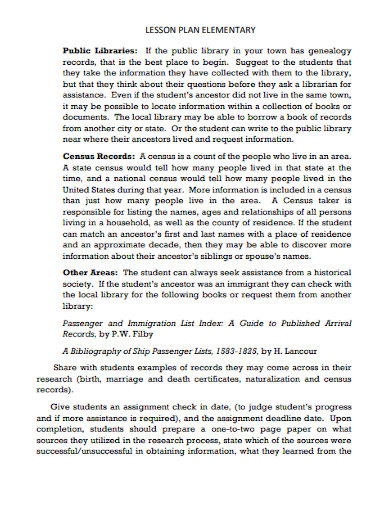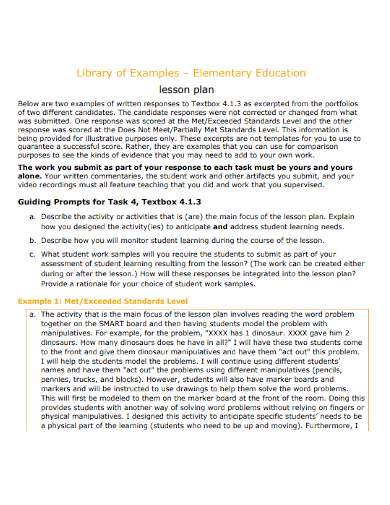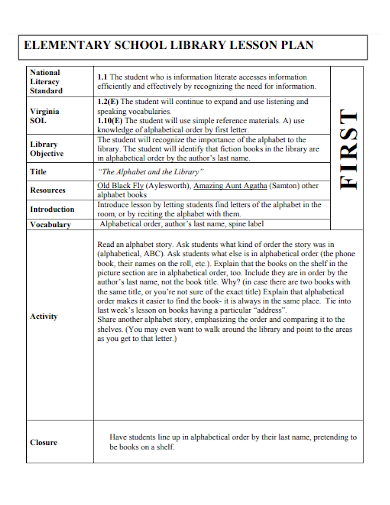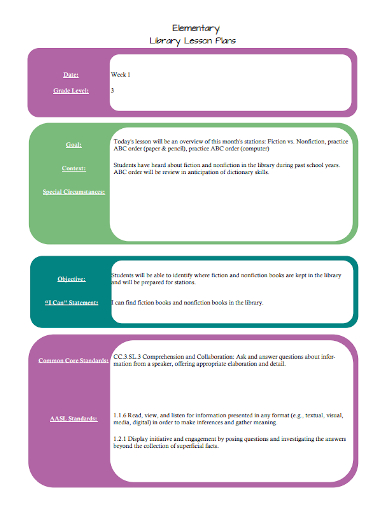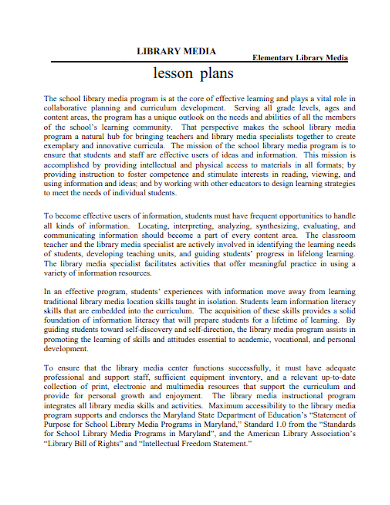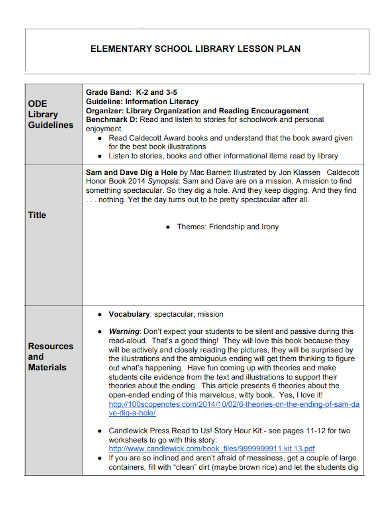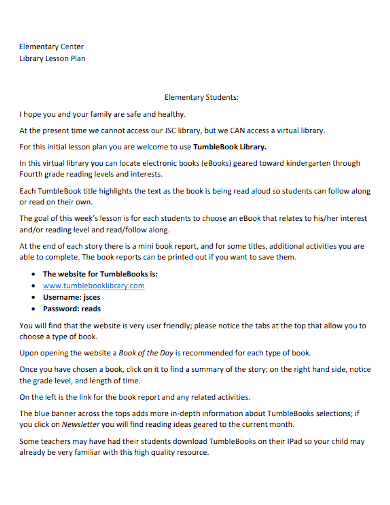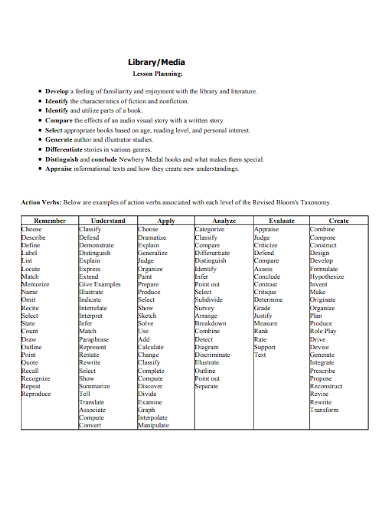Making an effective lesson plan for your library lessons takes a lot of time, dedication, effort, and an understanding of students’ classroom abilities and learning goals. As a teacher, one strives hard to motivate their students to retain the lessons being taught to them and apply their learnings in various ways. The role of a teacher is to conduct the lesson as outlined in their lesson plan to achieve the goal of the course they are assigned to teach to students. Sine lesson planning takes a huge time commitment for teachers, having a lesson plan template can save time from preparing them and let the teachers focus more on creating lessons. If you want to learn how to effectively write a lesson plan, you’re in the right place. This article will guide you on how to make an elementary lesson plan.
10+ Elementary Library Lesson Plan Samples
1. Elementary Library Lesson Plan Template
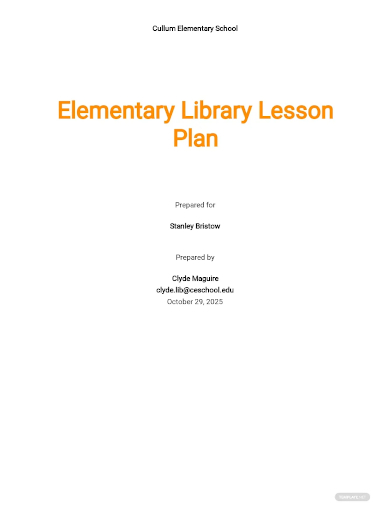
2. Elementary Library & Computer Lesson Plan
3. Elementary Public Library Lesson Plan
4. Lesson Plan for Elementary Classrooms and Libraries
5. Elementary Education Library Lesson Plan
6. Elementary School Library Lesson Plan
7. Printable Elementary Library Lesson Plan
8. Elementary Library Media Lesson Plan
9. Editable Elementary Library Lesson Plan
10. Elementary Center Library Lesson Plan
11. Basic Elementary Library Media Lesson Plan
What is a Lesson Plan?
A lesson plan is a roadmap teachers create to structure daily activities in their classes. The one or two paged document outlines what students will learn during each class, how each lesson will be taught, and how their progress will be measured. The sections are split into different sections which define what will happen in each class session.
Details to Include in an Elementary Library Lesson Plan
1. Lesson Objectives
The first step in creating a lesson plan is to figure out your objectives. The objectives are what you want your students to know and how to do it at the end of the lesson. To obtain your objectives you can refer back to the curriculum set in your school. Make sure the objectives are measurable and easily assessed by teachers and achievable for all students. When you write the objectives, they should be written clearly without unnecessary jargon.
2. Learning Requirements
Include lesson requirements in the lesson plan to let students understand why they are learning the lessons being taught to them and how can they make the connections across topics. So when you create the lesson requirements, you are involving your students in the planning process.
3. Lesson Materials
There are a lot of resources or materials that will aid you in planning your lessons. Some examples of these are videos, presentations, worksheets, classroom games, etc. When you write your lesson materials in the lesson plan, lay out what you need and where you and your students can find them. Make sure the materials you use are relevant to the success of the students’ learnings.
4. Lesson Procedures
Lesson procedures determine what is going to happen in your classroom. This includes learning activities, independent practice, group work, and blended learning. Plan ways to help students warm up their skills to adjust learning to their lessons and practice it for themselves or to introduce a new topic to them.
5. Grading and Assessment Methodology
When you get to the end of your lesson, create techniques that help you assess the level of understanding of your students to wrap up your lesson. Some examples of assessing student knowledge are formative assessments, quizzes and exams, and quick class surveys. Include these materials in your lesson plan to help students understand what’s expected of them, and ensure you’re using curriculum-based measurements to truly assess learning.
6. Lesson Plan Outline
Once you’re done putting all the information needed for the lesson plan it’s time to build a lesson plan outline to help make the process smoother. Make a space to add in your learning objectives, materials, and methods. If you need to add a page, you can do so as long as each section has enough space for its information. Add space at the end of the lesson plan to record your observations after the lesson so you can use the information to make the next plan better.
What are fun library activities to do with students?
- Taking Care of Books: Make sure you chat with your class about the best way to use the library and its books.
- Library Lingo: Students can research their library vocabulary to find out exactly what the library is all about.
- Book Report: Students can do an old-fashioned book report where they will develop their critical thinking skills in reading and understanding the themes of the books they read.
- Reading Centre Activities: Guided reading and independent reading groups can be done in the library to help students learn how to read well.
What library information lessons should be taught to students?
- Recognize and appreciate all library rules.
- Understand proper book care.
- locate books and replace them properly on the shelves they belong to.
- Select books for a variety of purposes.
- Develop an appreciation for authors and illustrators.
- Select material appropriate to students’ reading level.
- Appreciate a variety of book genres.
- Define and locate the reference collection.
- Understand the arrangement of materials in the library’s collection.
- Learn and understand the aspects of the research process.
Once you’re done creating the lesson plan, create multiple copies of it and make sure to keep at least one copy to keep at your desk. Save the lesson plan outline you’ve used so when the time comes to plan for your lessons for another unit or grade level or subject, you already have a detailed outline you can use. You can also download our free sample templates above to use as your reference!
Related Posts
FREE 7+ Fashion Business Plan Samples in PDF
FREE 10+ Sprint Planning Samples In MS Word | Google Docs | PDF
FREE 10+ Wedding Planning Samples in MS Word | Apple Pages | Powerpoint | PDF
FREE 9+ Monthly Study Planner Samples in PSD | Illustrator | InDesign | PDF
FREE 9+ Sample Curriculum Planning Templates in PDF | MS Word
FREE 10+ Teacher Development Plan Samples in MS Word | Google Docs | Apple Pages | PDF
FREE 10+ Basketball Practice Plan Samples in PDF
FREE 12+ School Business Plan Samples in PDF | MS Word | Apple Pages | Google Docs
FREE 7+ Client Strategic Plan Samples in PDF | MS Word
FREE 11+ Trucking Business Plan Templates in PDF | MS Word | Google Docs | Pages
FREE 7+ Small Hotel Business Plan Samples PDF | MS Word | Apple Pages | Google Docs
FREE 14+ Bakery Business Plans in MS Word | PDF | Google Docs | Pages
FREE 4+ Yearly Lesson Plan Samples in PDF
FREE 50+ Strategic Planning Samples in Google Docs | Pages | PDF | MS Word
FREE 10+ Construction Project Plan Samples in MS Word | Google Docs | Apple Pages | PDF


